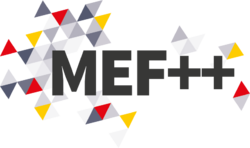Software:MEF++
 | |
| Original author(s) | GIREF and Université Laval |
|---|---|
| Initial release | 1996 |
| Written in | C++ |
| Available in | French |
| License | proprietary |
| Website | www |
MEF++ is a computer simulation software implementing the finite-element method, written in C++ and developped at Université Laval by the Groupe Interdisciplinaire de Recherche en Éléments Finis (GIREF).[1]. MEF++ is a general[2] software tool that enables the resolution of various problems [3], one of its special features being the resolution of very large size multi-physics problems[4]. MEF++ uses the PETSc library for solving linear systems and the interface provided by the MPI norm for parallel computing.
History
In 1995, the GIREF was composed of researchers from various fields (civil, mechanical and chemical engineers and also mathematicians) willing to have a common finite element modeling tool that will suite their common needs.[5][6] A developper teams was put together in 1996[7] to answer these needs. Working to code the algorithms and numerical methodologies developed within the GIREF reserach activities. Since 2007[8], theses efforts are financially sustained by the Natural Sciences and Engineering Research Council of Canada (NSERC) and industrial partners: Michelin since 2006, followed by Hydro-Québec and Bodycad since 2017.
Features
MEF++ is a general finite elements software completely parallelized [9] [4] which use PETSc (providing iterative methods, but also direct solvers as MUMPS, SuperLU, MKL PARDISO), PARMETIS [10] or PTSCOTCH, TAO [11] and the MPI norm. MEF++ is offering functionalities[7] for anisotropic mesh adaptation [12] [13] , solving steady or unsteady 1D-2D-3D problems, deformable-deformable friction contact problems, fluid structure interaction, shape optimization, large deformations[14] and mechanical damage computations[15] [16]
Being a shared development effort involving academic and industrial partners, and thus aiming for a well verified stability and numerical reproducibility other time, developments inside MEF++ framework are integrated thanks to a version control solution and a software quality insurance process. Part of this process is the release and test of nightly builds on more than 15 different environments with more than 2700 non-regression tests. Sample of these nightly builds are publicly accessible.[17]
See also
References
- ↑ Guénette, R.; Fortin, A.; Labbé, J.; Marcotte, J. P. (2004). "Iterative solvers for quadratic discretizations of the generalized Stokes problem". International Journal for Numerical Methods in Fluids 44 (7): 695–720. doi:10.1002/fld.581. ISSN 0271-2091.
- ↑ Kenny, G., Therrien, R., Fortin, A., Tibirna, C. (2004), Large-scale mass transport modelling in discretely-fractured porous media, 5th Joint CGS/IAH Groundwater Specialty Conference, Québec, pp. 8 p. (Note: October 24-27).
- ↑ https://evalorix.com/wp-content/uploads/2018/10/5-ULaval-MEF-mod%C3%A9lisation-et-simulation.pdf
- ↑ 4.0 4.1 "MEF++ a résolu un problème à 4.6 milliards d’inconnues – GIREF" (in fr-FR). https://giref.ulaval.ca/2019/04/28/mef-a-resolu-un-probleme-a-4-6-milliards-dinconnues/.
- ↑ "GIREF - Recherche". 1998-01-25. https://web.archive.org/web/19980125104100/http://www.giref.ulaval.ca/GIREF/html/listeprj.htm.
- ↑ "GIREF - La nécessité de développer l'interdiciplinarité". 1998-01-25. https://web.archive.org/web/19980125104026/http://www.giref.ulaval.ca/GIREF/html/inter.htm.
- ↑ 7.0 7.1 http://www.crm.umontreal.ca/pdf/Fortin.pdf
- ↑ Government of Canada, Natural Sciences and Engineering Research Council of Canada (2016-06-28). "CRSNG - Profils de titulaires de chaire". http://www.nserc-crsng.gc.ca/Chairholders-TitulairesDeChaire/Chairholder-Titulaire_fra.asp?pid=557.
- ↑ Journal du colloque des étudiants de 1er cycle en mathématiques de l’Université Laval, Volume 5, Septembre 2011, pp. 7-11, https://www.mat.ulaval.ca/fileadmin/mat/documents/PDF/Journal2011.pdf#page=11
- ↑ Karypis, G.; Kumar, V. (1999). "A fast and high quality multilevel scheme for partitioning irregular graphs". SIAM Journal on Scientific Computing 20 (1): 359. doi:10.1137/S1064827595287997.
- ↑ Benson, S.; McInnes, L.C.; More, J.J.; Sarich, J. TAO users manual (Technical report). United States. doi:10.2172/822565.
- ↑ Belhamadia, Youssef; Fortin, André; Chamberland, Éric (2004). "Anisotropic mesh adaptation for the solution of the Stefan problem". Journal of Computational Physics 194 (1): 233–255. doi:10.1016/j.jcp.2003.09.008. ISSN 0021-9991.
- ↑ Belhamadia, Youssef; Fortin, André; Chamberland, Éric (2004). "Three-dimensional anisotropic mesh adaptation for phase change problems". Journal of Computational Physics 201 (2): 753–770. doi:10.1016/j.jcp.2004.06.022. ISSN 0021-9991.
- ↑ Chamberland, É.; Fortin, A.; Fortin, M. (2010). "Comparison of the performance of some finite element discretizations for large deformation elasticity problems". Computers & Structures 88 (11-12): 664–673. doi:10.1016/j.compstruc.2010.02.007. ISSN 00457949.
- ↑ Crabbé, B.; Marigo, J.-J.; Chamberland, E.; Guilié, J. (2017). "Gradient damage models in large deformation". Constitutive Models for Rubber X (CRC Press ed.). pp. 335–340. doi:10.1201/9781315223278-53. ISBN 978-1-315-22327-8.
- ↑ Crabbé, B.; Marigo, J.-J.; Chamberland, E.; Guilié, J. (May 2017). "Etudes des modèles d'endommagement à gradient en grandes déformations". 13ème colloque national en calcul des structures (Giens, Var). https://hal.archives-ouvertes.fr/hal-01899363.
- ↑ "MEF++: Compilations automatiques". https://giref.ulaval.ca/AQL/.
External Links
Category:Computer-aided engineering software for Linux
List of finite element software packages
Category:Finite element software for Linux
Category:Numerical analysis
Category:Numerical analysis software for Linux
Category:Scientific simulation software

